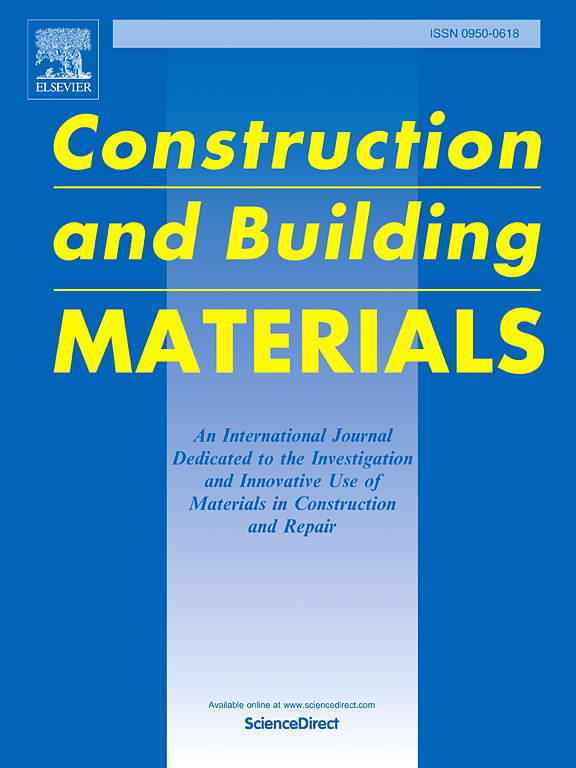Leaching-abrasion behaviour of canal lining concrete under alternating effect of freeze-thaw and low-velocity flowing water
IF 7.4
1区 工程技术
Q1 CONSTRUCTION & BUILDING TECHNOLOGY
引用次数: 0
Abstract
Under long-term alternating effect of freeze-thaw and low-velocity flowing water, characterising the leaching-abrasion behaviour of canal lining concrete has become a technical bottleneck in evaluating its durability in cold regions. To investigate this behaviour and elucidate the mechanisms and effects of these processes, this study conducted experiments under alternating freeze-thaw and flowing water conditions, with a maximum flow velocity of 5 m/s. The evolution of macro- and micro-scale properties, as well as phase composition, was analysed, and boundary movement criteria were established for concrete surface. The experimental results show that the abrasion depth of concrete increases linearly with service time. Compared to warm regions and static water environments, the combined effect of freeze-thaw cycles and flowing water in cold regions accelerates the leaching-abrasion rate by approximately 8 times. The rate is further amplified by factors of 1.18, 1.37, 1.22, 1.29, and 1.37 at flow velocities of 1, 2, 3, 4, and 5 m/s, respectively. This enhancement is primarily attributed to the deterioration of interfacial transition zone. Freeze-thaw are the dominant factor, inducing numerous microcracks, while flowing water significantly accelerates calcium leaching. Boundary movement on the concrete surface occurs when the residual solid calcium content and aggregate protrusion height reach critical values. The critical calcium content is 25 %, while the protrusion height decreases linearly with increasing aggregate diameter, reaching 60 % and 30 % for diameters of 4.75 and 9.5 mm, respectively. Under the action of leaching-abrasion alone, flowing water at velocities up to 5 m/s significantly accelerates leaching but causes negligible abrasion.
冻融与低速水流交替作用下渠道衬砌混凝土的浸磨特性
在冻融和低速水流的长期交替作用下,表征渠道衬砌混凝土的浸磨特性已成为寒地条件下评价渠道衬砌混凝土耐久性的技术瓶颈。为了研究这种行为并阐明这些过程的机制和影响,本研究在最大流速为5 m/s的冻融和流水交替条件下进行了实验。分析了宏观和微观尺度性能的演变以及相组成,建立了混凝土表面的边界移动准则。试验结果表明,混凝土磨损深度随使用时间的增加呈线性增长。与温暖地区和静态水环境相比,寒冷地区冻融循环和流水的共同作用使淋溶磨损速率加快了约8倍。当流速分别为1、2、3、4和5 m/s时,速率进一步放大为1.18、1.37、1.22、1.29和1.37倍。这种增强主要是由于界面过渡区的恶化。冻融是主要因素,引起大量的微裂缝,而流动的水显著加速钙的浸出。当残余固体钙含量和骨料突出高度达到临界值时,混凝土表面发生边界移动。临界钙含量为25 %,而突出高度随着骨料直径的增加呈线性降低,在骨料直径为4.75和9.5 mm时分别达到60 %和30 %。仅在浸出-磨损作用下,水流速度高达5 m/s时显著加速浸出,但对磨损的影响可以忽略不计。
本文章由计算机程序翻译,如有差异,请以英文原文为准。
求助全文
约1分钟内获得全文
求助全文
来源期刊

Construction and Building Materials
工程技术-材料科学:综合
CiteScore
13.80
自引率
21.60%
发文量
3632
审稿时长
82 days
期刊介绍:
Construction and Building Materials offers an international platform for sharing innovative and original research and development in the realm of construction and building materials, along with their practical applications in new projects and repair practices. The journal publishes a diverse array of pioneering research and application papers, detailing laboratory investigations and, to a limited extent, numerical analyses or reports on full-scale projects. Multi-part papers are discouraged.
Additionally, Construction and Building Materials features comprehensive case studies and insightful review articles that contribute to new insights in the field. Our focus is on papers related to construction materials, excluding those on structural engineering, geotechnics, and unbound highway layers. Covered materials and technologies encompass cement, concrete reinforcement, bricks and mortars, additives, corrosion technology, ceramics, timber, steel, polymers, glass fibers, recycled materials, bamboo, rammed earth, non-conventional building materials, bituminous materials, and applications in railway materials.
 求助内容:
求助内容: 应助结果提醒方式:
应助结果提醒方式:


